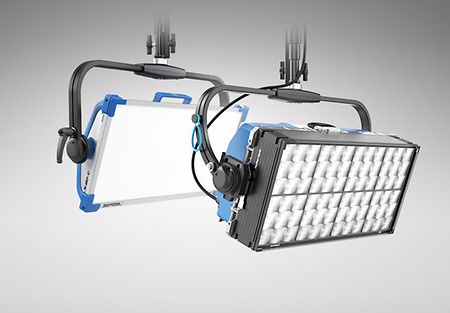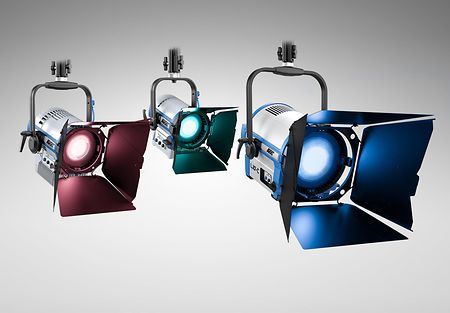One of the few female gaffers in France, Sophie Lelou has been working in lighting for 23 years. She became a gaffer in 2011, and her list of achievements includes acclaimed films such as “Victoria,” “Custody,” “My Donkey, My Lover & I,” and “Knife + Heart.” In her work on set, she uses ARRI fixtures such as SkyPanels, M-Series, or L-Series lights on a daily basis.
The early years: How Sophie Lelou became a gaffer
Passionate about cinema since her teenage years, Sophie Lelou earned a BTS degree in Audiovisual where she was introduced to operating and lighting. After various internships on sets, she realized that she was attracted to lighting work. “When I left the course, I contacted DP Thierry Arbogast who referred me to his gaffer Claude Hirsch. I was able to work on ‘The Crimson Rivers,’ before I went on to ‘Amélie.’ At the same time, I worked as a camera assistant. I wasn’t learning the same things, but these are two complementary jobs. Many people told me that I couldn’t do both, that I had to choose, but I enjoyed navigating between the lighting and camera crew. I did that for years, until DP Bertrand Mouly asked me to be his gaffer on the feature film ‘You’ll Be a Man’ by Benoît Cohen. I was very curious to occupy this position for the first time. In the end, everything went very well. Everyone was kind to me, both on set and at the rental houses. I said to myself, ‘You can do this!’”
“Before, I was maybe unconsciously censoring myself because I didn’t have any role models of women gaffers. In fact, the timing was very good. I was getting bored as an electrician. After this first feature film, the projects came one after another: ‘High Society’ by Julie Lopes-Curval, ‘The Apaches’ by Nassim Amaouche, both with DP Céline Bozon. It all happened by itself, in a very fluid and natural way. I feel at home as a gaffer. What I appreciate most about my job is telling stories. I also like to be on a project from A to Z, to arrive very early, prepare the film, go on location scouting, dialogue with the cinematographer, the director, and the set designer, to see how the light is going to be set up in the sets. I really feel like I'm part of the film.”
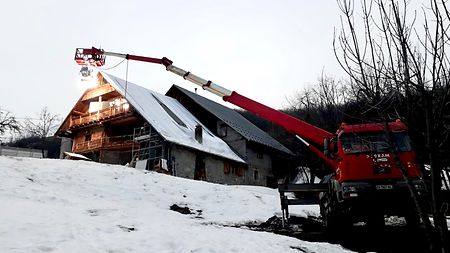
An ARRIMAX 18/12, 45 meters high on a gondola, during the “Anatomy of a Fall” shoot
Above all, cinema is made up of professional encounters. The one with cinematographer Simon Beaufils has left a lasting mark on Sophie Lelou’s career. “We worked together for the first time on Valeria Bruni Tedeschi’s ‘The Three Sisters’ for three intense weeks. After that, we almost never left each other. On set, Simon likes to work with HMI and tungsten. The material of the light is not the same with these projectors as with LEDs. It’s something almost indefinable. On Justine Triet’s new film, ‘Anatomy of a Fall,’ we shot for six weeks in a chalet in the mountains, with large windows that formed a 150-degree backdrop. We also had night and day exteriors in the snow. To create the light inputs, we installed an ARRIMAX on a gondola 45 meters above the ground. It was the only solution to light the three levels of the chalet on the side of the mountain and to compensate the level of the backdrops on the sunny snow.”
ARRI M-Series lights on set of “Anatomy of a Fall”
“Simon and I rely heavily on the ARRI M-Series. On the shoot, we used M90, M40, and M18 lights. Their performance is very good. We use them a lot reflected. They are all very soft, but also very powerful. This allows us to use them on a wide range of shots. To illuminate the chalet's decor from the sides, we also installed M90s on gantries, towers, or ‘Long Johns,’ depending on the height difference. In the interiors, there were almost no projectors. We relied on the incoming light, played on reflection and diffusion, and sculpted the light. We laid out grey or ecru sheets on the floor to unblock the shadows and avoid the red dominance of the floor on the faces. There was also a real problem with the power supply at an altitude of 1800 meters. We had two 36 kW connections on the network, a phase coupler for the 18 kW, but it was not enough. We had to install a 40kW site generator and bring in a tanker to supply it with fuel. It was quite cumbersome to organize but there was no alternative because there is no LED with that much power today.”
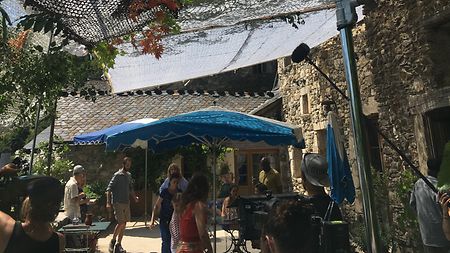
For exterior scenes in “My Donkey, My Lover & I,” Sophie Lelou had diffusing cloths stretched above the actors
On the magnificent “My Donkey, My Lover & I” by Caroline Vignal, still with DP Simon Beaufils, Sophie Lelou faced a completely different lighting problem, because the film was shot in nature settings for the most part. “For the exteriors in the mountains, I used a lot of reflectors and I sometimes placed a diffusion frame above the main characters to try to tone down the sunlight. I did all the location scouting with the Sun Seeker app, which allows you to see the exact path of the sun at a given date and time.
Preparing a shoot according to the position of the sun
With Simon, we did a lot of preparation and thinking to know when and where to shoot, according to the position of the sun. This allowed us to organize the shooting days in the best possible way, to be able to film in the right axes at the right time. For the meal scenes on the terrace, I had diffusing cloths stretched above the actors. We also used camouflage netting to create shadows and soften the light. Sometimes, we also used fake branches to create shadows. In the interiors of the lodgings, we mostly used M90s and M40s through the windows. I get along very well with Simon. We exchange a lot of ideas. He tells me what he has in mind for a film and I suggest things. We see what is possible. We have made ten films together. Each time, we try to push things a little further. It’s very motivating.”
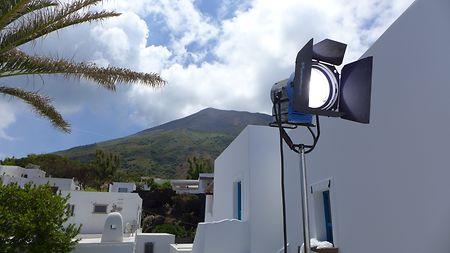
An ARRIMAX on set of “Sibyl,” shot on ALEXA Mini by DP Simon Beaufils
Working with the ARRI L7-C on “Ma France à moi”
Most recently, Sophie Lelou reunited with DP Bertrand Mouly, who she started out with as a gaffer, on Benoît Cohen’s new feature film “Ma France à moi.” “It was a great shoot with a very good atmosphere. Benoît knows how to surround himself with talented and benevolent people. In a night scene, I used the ARRI L7-C for the first time, a tool I didn’t know very well. It’s a Fresnel LED that proved to be very interesting to use. We were shooting at night in Paris, without power. I used the L7-C to bounce off the buildings to light the Quai de Valmy. The fixture was connected only to an energy case. It was very practical.”
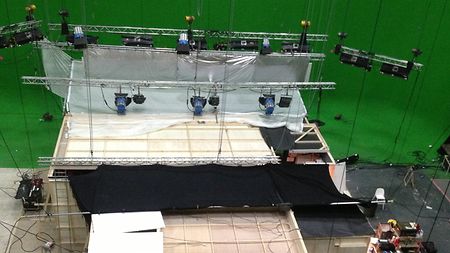
Six ARRIMAX on set of “Victoria,” shot on ALEXA by DP Simon Beaufils
On Xavier Legrand’s remarkable first film “Custody,” Sophie Lelou worked with DP Nathalie Durand to create a subtle lighting design suitable for the film’s very strong theme. “I had already worked with Nathalie and Xavier on ‘Just Before Losing Everything,’ her short film that won a César Award and was nominated for an Oscar. In fact, we are currently preparing his next feature film. On ‘Custody,’ Nathalie wanted a discreet light, which would be at the service of the direction. We were looking to be accurate, as close as possible to the different atmospheres in which the actors had to immerse themselves, even to the limit of what was visible at times. The light had to be an actor in the film. For this, we used tungsten sources in reflection, as for the bathroom scene. The idea was to be really precise.
ARRI SkyPanels on the list for all of Sophie Lelou's projects
We also had LED pipelines that we could hide easily. For the apartment set, shot in the studio, we used, among other things, M18s for the windows and SkyPanel S60-Cs on gantry to light the canvas printed backdrop. It was very convenient to finally have a clean, diffused, powerful, DMX-controllable, LED source for which I could change the intensity without changing the color temperature. I have SkyPanels on my list for all my movies, even if I don’t necessarily use them as a first intention. I use them mostly for support, but I always have them available. The ARRI LED panel is good and very clean. I really like the SkyPanel S60-C. It is powerful. Sometimes I do the face with it, using it with a Chimera accessory.”

“I had to fight to prove that I was capable and justify my place,” says Sophie Lelou
In parallel to her work as a gaffer, Sophie Lelou actively participates in the “Femmes à la camera” (“Women behind the Camera”) collective, which campaigns for a greater presence of women in the film industry. This association is part of the “50/50” collective, which works for parity, equality, and diversity in the film and audiovisual industries. “The subject interests me a lot. I knew the pioneers of ‘Femmes à la caméra,’ cinematographers Céline Bozon, Claire Mathon, and Nathalie Durand, among others. It’s important to have a space to exchange, to talk about the situations and challenges we face, without feeling judged.”
Fighting for gender equality in the film industry
The collective is also fighting against sexist abuse on set. The #MeToo movement has helped a lot with awareness and spreading the word. A hotline called “Femmes à l'écoute” has been set up with volunteers so that women technicians can report problems on film sets, as it is very important that women do not feel alone when there are abuses happening on a shoot.
“Within the collective, we also talk about the glass ceiling for women in camera crews. They often don't have access to feature films or big budget commercials. We are also campaigning to open the doors to women technicians and to change the way different collaborators look at the subject. More and more, I am contacted by young women who ask me how to become a gaffer. When I started out, I was lucky enough to work with directors like Michel Sabourdy, Claude Hirsch, Franck Barrault, and Mikael Monod, who gave me the opportunity to be part of their teams. On some projects, it was not always easy to be the only woman in the lighting team. In the beginning, some people had trouble taking me seriously. I had to fight to prove that I was capable and justify my place. When I became a gaffer, some productions asked if I would be able to manage my team. Things have changed since then, but we must continue to change mentalities, to get away from commonplaces about women in the film industry. Today, I am the proof that being a woman gaffer is possible, and I encourage those who are passionate about lighting to follow their desires and go for it.”
Opening image: Manuel Moutier

